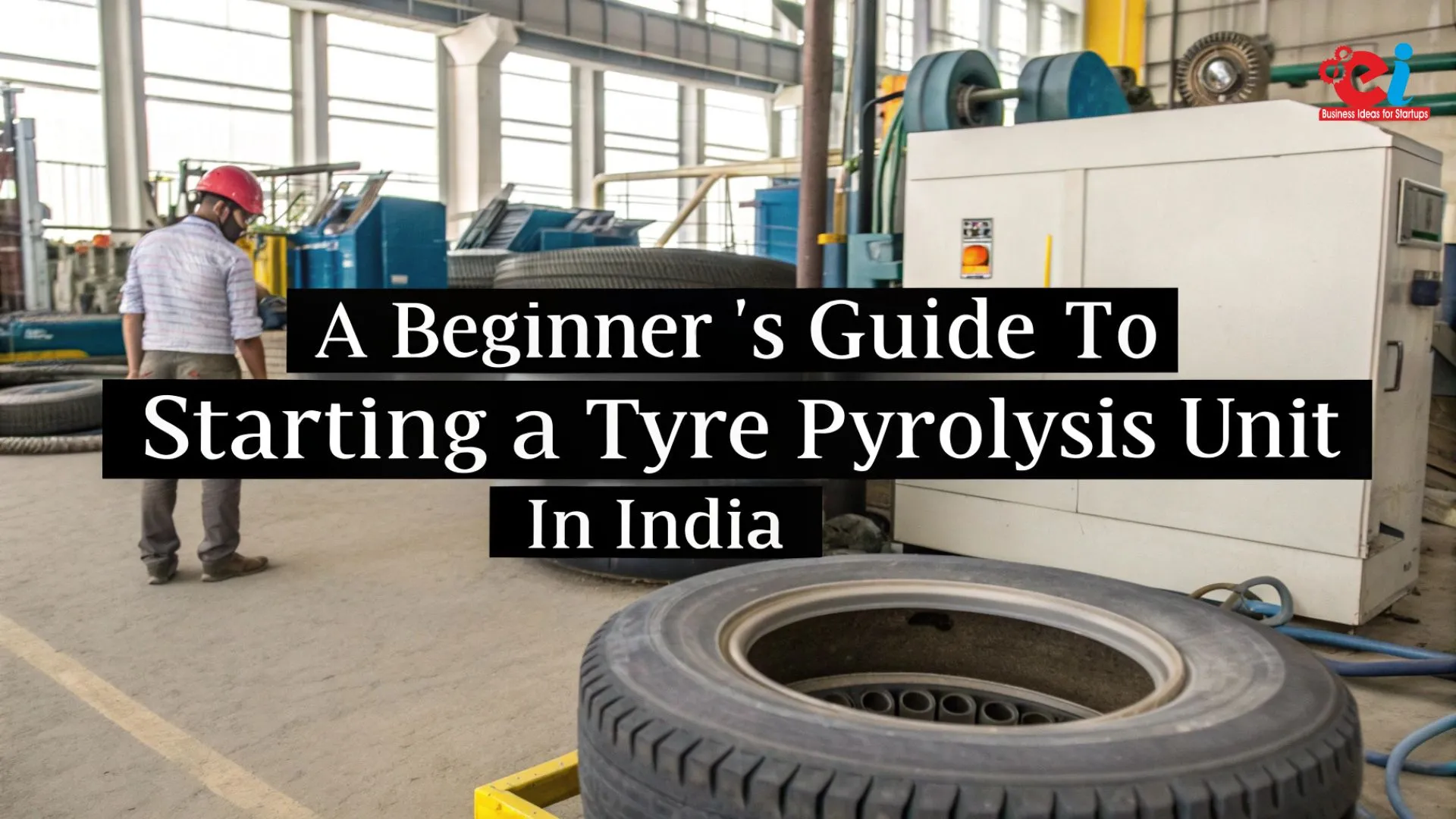The waste tyre issue is now viewed within the framework of a circular economy and climate-aware industries as a multibillion-dollar business opportunity. More than 1.5 billion tyres are disposed of annually across the globe, creating an enormous environmental risk. Innovation in pyrolysis technology enables the conversion of waste tyres into fuel oil, carbon black, and even steel wire, which are industrial products in high demand. There is a growing recognition among entrepreneurs on the profitability potential in tyre pyrolysis businesses – sustainable models that turn pollution into profit.
Understanding Tyre Pyrolysis Technology
Tyre pyrolysis is a process where the material undergoes thermal decomposition in oxygen-free environments. Heating waste tyres at high temperatures breaks down rubber polymers into valuable products like pyrolysis oil, recovered carbon black (rCB), syngas, and scrap steel.These by-products can alternatively serve as fuels and chemical feedstocks or construction additives and reinforcement materials which have established industrial applications.
Lummus-InnoVent Tyre Pyrolysis MoU: A Market Signal
The recent Memorandum of Understanding (MoU) between Lummus and InnoVent for tire pyrolysis innovation illustrates the increased reliance on advanced technological processes to assist global sustainability efforts. Their partnership builds modular pyrolysis units to turn end-of-life tyres into hydrocarbons, which refineries process into petrochemicals. Developments such as these instill confidence from industry giants while simultaneously paving paths for innovative entrepreneurs to pursue ventures in a blossoming industry.
Related: How to start Tyre Recycling Business?
What Makes Tyre Pyrolysis Hot for New Startups?
There are distinct reasons why new business entrants find tyre pyrolysis to be an optimal emerging opportunity:
- Increasing Volume of Tyre Waste: India generates over 2.75 lakh tonnes of tyre waste every year. Only 30% of this waste is recycled which shows a gaping hole for improvement.
- Government Focus on Circular Economy: Extended Producer Responsibility (EPR) policies encourages both recovery and reuse, creating an opportunity for investment.
- High Margin Outputs: The pyrolysis oil and carbon black has high demand in the industrial sector which continues to increase with every passing year.
- Absence of Competitors in High-Tech Focused Area: Though traditional recyclers exist, high-quality & downstream value addition fueled pyrolysis remains relatively low when it comes to competition.
- Export Opportunities: Regions in Europe and Asia are paying more attention to sourcing recovered carbon black (rCB) and renewable oils.
Key Products and Their Market Potential
1. Pyrolysis Oil
A type of liquid fuel similar to furnace oil, frequently utilized in boilers, kilns, and generators. Further refinement can enable its utilization in petrochemicals along with specialty chemicals.
2. Recovered Carbon Black (rCB)
This product finds application in manufacturing rubber, plastics, paints and inks. Its value increases vastly when maintained purity standards are upheld.
3. Steel Wire
This scrap is collected from radial tyres and sold to steel recyclers.
4. Syngas
The pyrolysis plant can use this energy internally, reducing dependence on external energy sources.
Related: Maximizing Profits with a Sustainable Waste Tyre Pyrolysis Plant: A Comprehensive Guide
Starting Considerations Before Entering Tyre Pyrolysis
This field requires significant self-investment, demanding careful strategic planning and strict adherence to technical concepts. These factors make it unique and pose challenges for new businesses entering the market. Entrepreneurs have to keep these factors in mind:
- Technology Choice: The cost and efficiency doesn’t vary only with technology but also the type of system in use such as batch, semi-continuous or continuous pyrolysis systems.
- Permit Issues for Environment Protection Measure Compliance Strategies: The pollution control board grants permits with specific emission limits, which businesses must comply with to meet environmental protection standards.
- Feedstock Sourcing: Contact agreement with sponsoring institution associated offering municipal services or other auto repair facilities ensures constancy of input supply stability during periods of high demand.
- End Product Marketing: There must exist reliable suppliers for purchasing networks which requires trustworthiness. Associates under no-limit state agreements should act responsibly in private dealings, even without legal liability.
Capital Investment
Initial investment and outlay typically range from ?1.5 to ?5 crores, depending on the technology used and the plant’s capacity.
Location and Logistics
Being close to suppliers of raw materials as well as customers of the by-products reduces logistics costs.
Plant Setup and Overview of Processes
- Tyre Shredding: Tyres are shredded into equal portions to ensure easy loading into containers and reactors.
- Feeding into Reactors: The shredded tires are then placed into the pyrolysis reactor.
- Heating and Pyrolysis: These processes require temperatures between 400–500°C, and operators must keep oxygen away during heating to ensure effective breakdown of oils, gases, and solids.
- Condensation and Recovery: After vapor condensation and pyrolysis oil formation, carbon black and steel are separated.
- Gas Reuse: Syngas produced becomes a great energy resource for supporting fuel within the reactor, aiding in maintaining overall plant energy output balance.
Estimated Financials for a Pyrolysis Plant Processing 10 Tons Per Day
- Estimated Capital Cost: ?2.5–3.5 crores
Revenue Streams Include:
- Pyrolytic Oil (~45%)
- Carbon Black Residues (~35%)
- Steel (~12%)
- Gasses (~8%)
Payback Period: 2–3 years
Net Profit Margin: 18–25%
- Waste Management: Solid residues require careful processing under the hazardous waste regulations.
Global Progress in Tire Pyrolysis
- Carbon Black as Eco-Friendly Filler: Companies like Michelin and Goodyear are looking into recovered carbon black for added value as they work to reduce their reliance on virgin raw materials.
- Focus on Hydrocarbon Recovery: Some advanced pyrolysis systems now incorporate downstream hydroprocessing to recover naphtha and aromatics.
- AI Adoption: Next-gen plants use emission controls, smart quality assurance, and predictive maintenance for improved efficiency and compliance.
- Rural Area Modular Units: Decentralized waste management is pushing the popularity of scalable pyrolysis skid-mounted units.
What Steps Must Entrepreneurs Take to Achieve Unique Success
- Synthesize Your Own Detailed Feasibility Report: Be sure to gauge the spend level with the possible winning outcome from the investment of technology, finances involved, or any regulation perspectives.
- Acquire Suitable Technological Solutions: Look into purchasing pollution control semi-continuous or continuous reactors.
- Bind Yourself With Professionals: Partner with EPC companies, raw material collectors, industrial merchants – these players make up a crucial part of ecosystem interactions.
- Preserve Brand Image for Eco-Friendly Business Practices: Branding yourself as an institutional client would gain your business lots of favor due to it helping in the green transition.
- Focus All Efforts on R&D: Value catch lies with continuous improvement around oil distillation processes and/or ensuring greater product purity post-processing steps lead to better profit margins continuously over time.
Conclusion
The potential of tire pyrolysis technology goes far beyond recycling; it is a paradigm shift for today’s industrial entrepreneur. Startups in this space are able to combine profit and eco-friendly business strategies by converting one of the largest streams of solid waste into energy, chemicals, and construction materials. Visionary founders can now step up and leave their mark on sustainable manufacturing bolstered by the industry leaders Lummus and InnoVent who have already done extensive groundwork.
A Brief Overview of Niir Project Consultancy Services (NPCS)
For new entrepreneurs, NPCS prepares Market Survey cum Detailed Techno Economic Feasibility Reports.
Additionally, our reports detail the complete business process including manufacturing method, necessary raw materials, plant layout and finances.
With our assistance on evaluating setting up new industries or businesses, clients gain confidence and clarity for their projects.






